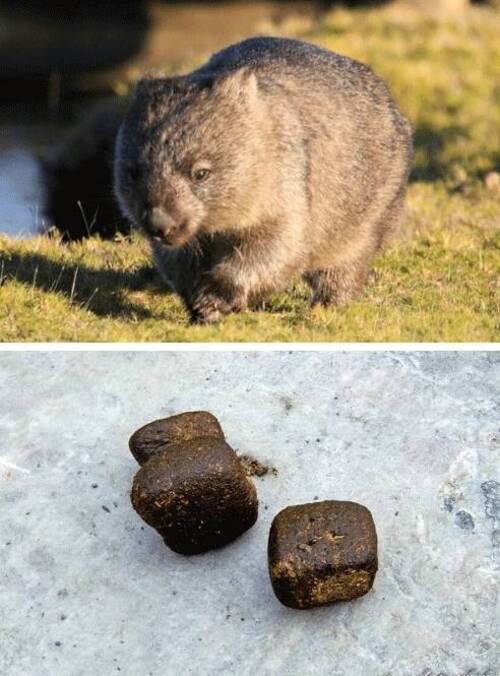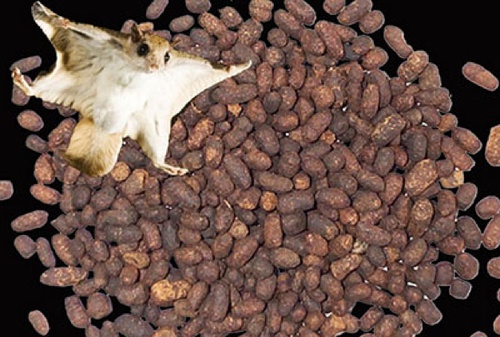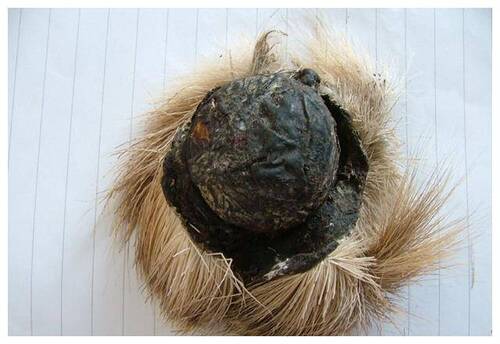In nature, excrement is more than just a waste disposal process. It also performs important ecological functions and sometimes has unique shapes and features. These special shapes not only help animals adapt to their environment, but also provide scientists with a wealth of information about their diet, health, and even behavior patterns. This article will explore some examples of animals with unusual excrement shapes and reveal the fascinating natural phenomena behind them.
The excrement of wombats is very special - their excrement is a perfect cube. Wombats are endemic to Australia, and their cube-shaped excrement is not a coincidence or anomaly, but a result of evolution. Wombats use these lumpy feces to mark their territory. Since their habitats are mostly rocky or uneven, cubic feces can stay in place more firmly than round or irregular feces and will not roll easily.
Colon wall structure: The colon of wombats has a unique structure and strength, which can compress the feces into blocks during the formation process.
Function: Cubic feces can mark territory more effectively and even become social signals to convey information to other wombats.

Bat feces (also known as bat guano) are unremarkable in appearance, but their texture is very unique. Since bats feed on insects, their excrement contains a lot of undigested insect shells. These shells will turn into fine powder after the feces are dried, and the feces are rich in nutrients and are often used as fertilizer, especially in the planting industry.
Food characteristics: Bats mainly eat flying insects. The main component of the exoskeleton of these insects is chitin, which is difficult to digest, so they are excreted in powder form.
Use: Bat feces are rich in nitrogen and phosphorus, often used in organic agriculture, and are high-quality natural fertilizers.

The shape of beaver feces is relatively simple, usually cylindrical, but its uniqueness lies in the smell. Beaver excrement is often accompanied by a sweet fragrance, which is due to the large amount of plant food they consume, especially the fragrant resin in tree bark. Beaver excrement is often used to mark territory, and its scent properties help them keep their territory safe near water sources.
Dietary structure: Beavers mainly feed on bark and aquatic plants, and the natural aromatic substances in some plants give their excrement a unique fragrance.
Function: Scented excrement can be used as a territory marker to warn other beavers to keep their distance.

The feces of sea turtles present a peculiar translucent jelly-like shape, especially after they eat jellyfish, the shape and texture of the excrement will be more special. This unique excrement form is because jellyfish are rich in water and have a jelly-like structure. The digestive system of sea turtles cannot completely decompose these water-rich tissues, so their feces appear jelly-like.
Food source: Sea turtles like to eat jellyfish, which contain a lot of water and gelatinous substances. After digestion, the feces discharged by sea turtles will appear jelly-like.
Ecological importance: Sea turtle feces play an important role in the marine ecosystem and help the circulation of nutrients in the ocean.
Rabbits have two different feces, one is hard spherical feces, and the other is called "cecal feces", which is a soft mushy mass. This feces is the product of re-fermentation during the rabbit's digestion of food. Rabbits will eat these cecal feces again to obtain more nutrients, especially vitamin B and other trace elements.
Digestive strategy: The rabbit's digestive system cannot fully absorb all nutrients at once, so the cecal feces produced by fermentation provide a second digestion opportunity.
Nutrient acquisition: Rabbits get more nutrients by eating these special feces, which is one of their unique survival strategies.
Tapirs are large mammals living in tropical rainforests. Their feces sometimes float on the water, forming a boat-like shape. Tapirs usually excrete in water, which helps them prevent natural enemies from tracking them and allows the feces to be spread with the water. Floating feces can also provide information to help scientists study their health and habitat.
Aquatic excretion habits: Tapirs prefer to excrete in water, and their feces will float with the current, thus being excreted in inconspicuous places.
Defense strategy: By excreting in water, tapirs can reduce odor exposure and prevent predators from tracking them.
Civets are famous for their coffee beans in their feces, and their feces contain undigested coffee berries. Civets feed on coffee cherries, absorbing only the pulp during digestion and excreting undigested coffee beans. These coffee beans are called "cat poop coffee" and are a rare high-end coffee ingredient.
Food digestion: Civets digest the pulp of coffee cherries, and the beans cannot be completely digested, so they will remain intact in the excrement.
Commercial value: This type of coffee bean is called "Civet Coffee" and is well-known in the global market for its unique flavor.
Goose feces are usually long and thin strips, and incompletely digested grass can often be seen in them. Because geese are herbivores with a short digestive system, their feces often have residual fiber, so the feces are rough and contain grass components. Goose excrement is common in farms and wetlands, and has a certain fertilizing effect on the soil.
Food structure: Geese mainly feed on grass and other plants, and incompletely digested plant fiber often appears in their excrement.
Farmland Fertilizer: Goose droppings can be used as fertilizer to provide additional nutrients for plants.
The shapes and characteristics of animal excrement not only show the diversity of nature, but also reflect the survival strategies of different species to adapt to the environment. From the cube-shaped feces of wombats to the coffee bean excrement of civets, each form has a unique ecological function. These special excrement forms provide scientists with valuable clues to study the health, diet and living habits of animals.
animal tags: wombat bat beaver turtle rabbit tapir civet goose
We created this article in conjunction with AI technology, then made sure it was fact-checked and edited by a Animals Top editor.